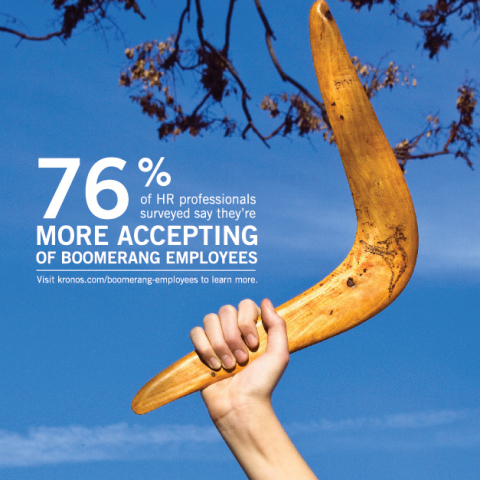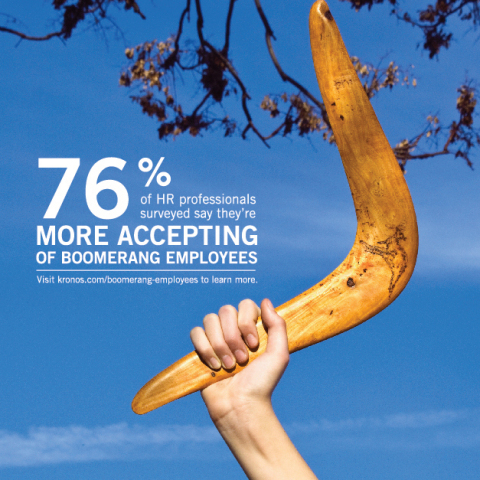CHELMSFORD, Mass.--(BUSINESS WIRE)--There’s a new type of candidate circling the hiring pool: the boomerang employee. Today, in the first study released in The Employee Engagement Lifecycle Series commissioned by The Workforce Institute at Kronos Incorporated and WorkplaceTrends.com, survey data shows a changing mindset about hiring boomerang employees – i.e. someone who left an organization, for whatever reason, and then rejoined that same organization at a later date.
In the national survey of more than 1,800 human resources (HR) professionals, people managers, and employees, responses indicate employee engagement should not end once the working relationship is over – especially between high-performing alumni and organizations with a strong corporate culture. However, this era of the boomerang employee creates a unique type of competition for job seekers and new challenges for organizations to maintain relationships with former high-performers.
Survey News Facts
-
Organizations and workers alike coming around on boomerang
employees.
- Based on the survey data, nearly half of HR professionals claim their organization previously had a policy against rehiring former employees – even if the employee left in good standing – yet 76 percent say they are more accepting of hiring boomerang employees today than in the past. Managers agree, as nearly two-thirds say they are now more accepting of boomerangs.
-
While only 15 percent of employees said they had boomeranged back
to a former employer, nearly 40 percent say they would consider
going back to a company where they once worked.
- Looking deeper, 46 percent of Millennials would consider returning to a former employer, compared to 33 percent of Gen Xers and 29 percent of Baby Boomers. In an era where job-hopping amongst young professionals has become the norm, this could suggest that Millennial employees might be leaving organizations too soon.
-
Boomerangs are creating increased – and unexpected – competition
for job seekers as the hiring market continues to improve.
- In the past five years, 85 percent of HR professionals say they have received job applications from former employees, and 40 percent say their organization hired about half of those former employees who applied.
- This high hiring rate is not surprising, since HR professionals (56 percent) and managers (51 percent) say they give very high or high priority to job applicants who were former employees that left in good standing. Conversely, only six and nine percent, respectively, say they give zero priority to former colleagues.
- Boomerangs are not the only type of job seeker adding increased competition, as 75 percent of HR professionals say that customers have also applied for positions at their organization, with 60 percent saying they have hired at least one former customer.
-
Familiarity, easier training, and knowledge of employer are
benefits for boomerangs and organizations – yet some concerns linger.
- HR professionals (33 percent) and managers (38 percent) agree that familiarity with the organization’s culture is the biggest benefit to hiring back former employees, while nearly one-third appreciate that boomerangs do not require as much training as a brand new employee.
- When employees were asked for the top reason they would go back to work for a former employer if pay was comparable, employee benefits and better career path tied for the number one response (20 percent each). However, this response varied greatly by generation.
- But while the overall acceptance of boomerang employees has changed direction, HR professionals and managers still have concerns. Nearly one-third of HR professionals and managers claim boomerang employees have a stigma hanging over their heads that they might leave again, and more than one-quarter say these employees may have the same baggage they originally left with.
-
HR says they have a strategy for maintaining relationships with
former employees, but workers and managers disagree.
-
While organizations appear increasingly more accepting of
boomerang applicants, 80 percent of employees say former employers
do not have a strategy in place to encourage them to return, with
64 percent saying there appears to be no strategy for maintaining
a relationship.
- Nearly half of managers say their organization has no alumni communications strategy.
-
HR practitioners, on the other hand, say they use several
strategies for keeping in touch with former high-performing
employees, including email newsletters (45 percent), recruiters
(30 percent), and alumni groups (27 percent).
- Facebook is the platform of choice for alumni groups according to HR professionals (42 percent), with email (39 percent) and LinkedIn (33 percent) close behind.
-
While organizations appear increasingly more accepting of
boomerang applicants, 80 percent of employees say former employers
do not have a strategy in place to encourage them to return, with
64 percent saying there appears to be no strategy for maintaining
a relationship.
Kronos News Facts
- Kronos currently has more than 180 active boomerang Kronites (Kronos employees) who have returned to work at the organization, including nearly 120 who have been re-hired since 2010.
- Many boomerang Kronites cite the Kronos corporate culture as a primary reason for returning to the organization, which is reaffirmed by recent employee engagement scores that far surpass industry benchmarks for global IT organizations.
- Nearly one-third of Kronos hires in the past 12 months have been from employee referrals.
- Kronos has won several top honors around the world as a best place to work, including recognition from The Boston Globe, Boston Business Journal, Forbes, the Great Place to Work® Institute India, and Canada’s The Globe and Mail.
- Kronos expects to hire 1,000 employees in 2015, and is actively hiring with more than 300 Kronos job openings worldwide.
Supporting Quotes
-
Joyce Maroney, director, The Workforce Institute at Kronos
“In an age defined by social media and job hopping, it’s much easier for employees to search for new opportunities and equally as easy for recruiters to poach talent from competitors. This fierce competition could be contributing to the changing mindset about boomerang employees. With this boomerang trend on the rise, it’s more important than ever for organizations to create a culture that engages employees – even long after they’ve gone – and organizations should consider how the boomerang employee factor should affect their off-boarding and alumni communications strategies for top performers.”
-
David Almeda, chief people officer, Kronos
“No one organization is the right fit for every employee and vice versa. Sometimes making a change is the best thing for both the employee and the employer. But this data shows that it’s mutually beneficial for highly engaged employees with outstanding performance and organizations with strong cultures to part ways in good standing. The best boomerang strategy for forward-thinking organizations is to ensure that employees are engaged and feel appreciated while at work – that way if employees decide to leave to explore other career options, the organization will be on the short list of employer options if their career situation changes and they are looking for a more positive opportunity.”
-
Dan Schawbel, founder, WorkplaceTrends, and New York Times
Bestselling Author of “Promote Yourself”
“Organizations should consider giving hiring priority to potential boomerang employees who were a great cultural fit because they can reach a high productivity level quicker if rehired. In previous research we’ve done, we’ve found that Millennials are switching jobs every two years because they are searching for the job – and organization – of best fit. But this new study indicates that this younger generation is more likely to boomerang back when they’ve experienced other company cultures and realized what they've missed. We will see the boomerang employee trend continue in the future as more employees adopt a ‘free agent’ mentality and more organizations create a stronger alumni ecosystem.”
Supporting Resources
- Note to editors: Cite survey as “The Workforce Institute at Kronos and WorkplaceTrends Employee Engagement Lifecycle Series: Boomerangs.”
- Be on the lookout for an upcoming Tweet Chat with The Workforce Institute on boomerang employees at #KronosChat.
- Listen to a recent Workforce Institute Radio podcast titled, “Boomerang Employees – Can You Go Home Again?”
- Check out books published by The Workforce Institute at Kronos.
- Connect with The Workforce Institute at Kronos via Twitter.
- Take a look at the lighter side of workforce management in our Time Well Spent cartoons.
- Connect with Kronos via Facebook, Twitter, Google+, LinkedIn, and YouTube.
- Subscribe to our workforce management blogs.
About The Workforce Institute at Kronos
The Workforce Institute provides research and education on critical workplace issues facing organizations around the globe. By bringing together thought leaders, The Workforce Institute is uniquely positioned to empower organizations with the knowledge and information they need to manage their workforce effectively and provide a voice for employees on important workplace issues. A hallmark of The Workforce Institute’s research is balancing the needs and desires of diverse employee populations with the needs of organizations. For additional information, visit www.workforceinstitute.org.
About Kronos Incorporated
Kronos is the global leader in delivering workforce management solutions in the cloud. Tens of thousands of organizations in more than 100 countries — including more than half of the Fortune 1000® — use Kronos to control labor costs, minimize compliance risk, and improve workforce productivity. Learn more about Kronos industry-specific time and attendance, scheduling, absence management, HR and payroll, hiring, and labor analytics applications at www.kronos.com. Kronos: Workforce Innovation That Works™.
About WorkplaceTrends.com
WorkplaceTrends.com is a research and advisory membership service for forward-thinking HR professionals. We have a large database of research covering all aspects of HR, from recruiting to employee benefits to training and development. Through our primary research studies, and collection of secondary surveys, we are following the most important trends and then sharing them with our member companies as they happen. Our corporate members have access to a wealth of knowledge at their fingertips, with real actionable advice. Our goal is to help our members prepare for the future of work, today.
Survey Methodology
Research findings are based on a survey fielded in the U.S. between July 14 and July 22, 2015. For this survey, 1,807 respondents were asked about their thoughts regarding various aspects of corporate culture and employee engagement. The study surveyed three separate groups: HR professionals (601 surveys); people managers (604 surveys); and full-time, non-managing employees (602 surveys). The survey was completed through Lightspeed GMI’s Global Test Market double opted-in panelists who have registered to participate in online surveys. All sample surveys may be subject to multiple sources of error (i.e. sampling error, coverage error, measurement error, etc.).
© 2015 Kronos Incorporated. All rights reserved. Kronos and the Kronos logo are registered trademarks and Workforce Innovation That Works is a trademark of Kronos Incorporated or a related company. See a complete list of Kronos trademarks. All other trademarks, if any, are property of their respective owners.




